Toaster
A toaster is a small electric appliance that uses radiant heat to brown sliced bread into toast.
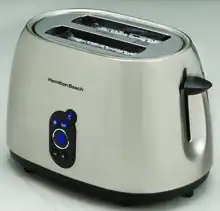
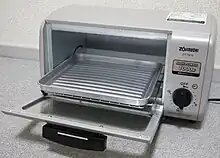
Types

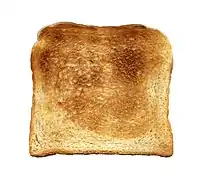
Pop-up toaster
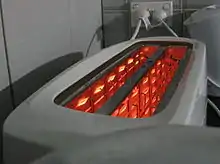
In pop-up or automatic toasters, a single vertical piece of bread is dropped into a slot on the top of the toaster. A lever on the side of the toaster is pressed down, lowering the bread into the toaster and activating the heating elements. The length of the toasting cycle (and therefore the degree of toasting) is adjustable via a lever, knob, or series of pushbuttons, and when an internal device determines that the toasting cycle is complete, the toaster turns off and the toast pops up out of the slots.
The completion of toasting may be determined by a timer or by a thermal sensor, such as a bimetallic strip, located close to the toast.
Toasters may also be used to toast other foods such as teacakes, toaster pastry, potato waffles and crumpets, though the resultant accumulation of fat and sugar inside the toaster can contribute to its eventual failure.
Among pop-up toasters, those toasting two slices of bread are more purchased than those which can toast four.[1] Pop-up toasters can have a range of appearances beyond just a square box and may have an exterior finish of chrome, copper, brushed metal, or any color plastic.[1] The marketing and price of toasters may not be an indication of quality for producing good toast.[1] A typical modern two-slice pop-up toaster can draw from 600 to 1200 watts.[2]
Beyond the basic toasting function, some pop-up toasters offer additional features such as:
- One-sided toasting, which some people prefer when toasting bagels
- The ability to power the heat elements in only one of the toaster's several slots
- Slots of various depths, lengths, and widths to accommodate a variety of bread types
- Provisions to allow the bread to be lifted higher than the normal raised position, so toast that has shifted during the toasting process can safely and easily be removed
Toaster oven
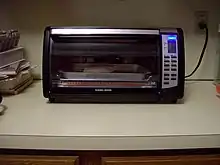
Toaster ovens are small electric ovens that provide toasting capability plus a limited amount of baking and broiling capability. Similarly to a conventional oven, toast or other items are placed on a small wire rack, but toaster ovens can heat foods faster than regular ovens due to their small volume. They are especially useful when the users do not also have a kitchen stove with an integral oven, such as in smaller apartments and in recreational vehicles such as truck campers.
Conveyor toaster
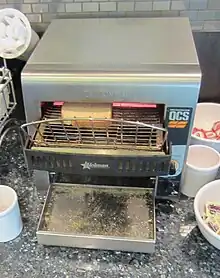
Conveyor toasters are designed to make many slices of toast and are generally used in the catering industry, restaurants, cafeterias, institutional cooking facilities, and other commercial food service situations where constant or high-volume toasting is required. Bread is toasted at a rate of 300–1600 slices an hour; the doneness control on such a toaster adjusts the conveyor speed, thus altering the time during which the bread is near the heat elements. Conveyor toasters have been produced for home use; in 1938, for example, the Toast-O-Lator went into limited production.[3]
History
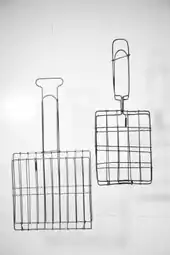
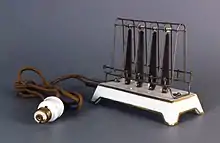
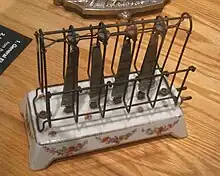
Before the development of the electric toaster, sliced bread was toasted by placing it in a metal frame or on a long-handled toasting fork[4] and holding it near a fire or over a kitchen grill.
From the 16th century onward, long-handled forks were used as toasters, "sometimes with fitment for resting on bars of grate or fender."[5]
Wrought-iron scroll-ornamented toasters appeared in Scotland in the 17th century.[6] Another wrought-iron toaster was documented to be from 18th-century England.[7]
Utensils for toasting bread over open flames appeared in America in the early 19th century, including decorative implements made from wrought iron.[8]
Development of the heating element
The primary technical problem in toaster development at the turn of the 20th century was the development of a heating element which would be able to sustain repeated heating to red-hot temperatures without breaking or becoming too brittle. A similar technical challenge had recently been surmounted with the invention of the first successful incandescent lightbulbs by Joseph Swan and Thomas Edison. However, the light bulb took advantage of the presence of a vacuum, something that could not be used for the toaster.
The first stand alone electric toaster, the Eclipse, was made in 1893 by Crompton & Company of Chelmsford, Essex. Its bare wires toasted bread on one side at a time.[9][10]
The problem of the heating element was solved in 1905 by a young engineer named Albert Marsh, who designed an alloy of nickel and chromium, which came to be known as Nichrome.[11][12][13][14]
The first US patent application for an electric toaster was filed by George Schneider of the American Electrical Heater Company of Detroit in collaboration with Marsh.[12][15] One of the first applications that the Hoskins company had considered for its Chromel wire was for use in toasters, but the company eventually abandoned such efforts, to focus on making just the wire itself.[13]
The first commercially successful electric toaster was introduced by General Electric in 1909 for the GE model D-12.[12][16][17]
Dual-side toasting and automated pop-up technologies
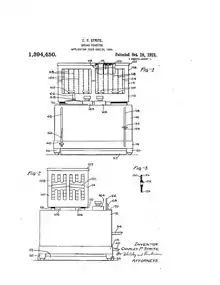
In 1913, Lloyd Groff Copeman and his wife Hazel Berger Copeman applied for various toaster patents, and in that same year, the Copeman Electric Stove Company introduced a toaster with an automatic bread turner.[18] Before this, electric toasters cooked bread on one side, meaning the bread needed to be flipped by hand in order to cook both sides. Copeman's toaster turned the bread around without having to touch it.[19]
The automatic pop-up toaster, which ejects the toast after toasting it, was first patented by Charles Strite in 1921.[20] In 1925, using a redesigned version of Strite's toaster, the Waters Genter Company introduced the Model 1-A-1 Toastmaster,[21] the first automatic, pop-up, household toaster that could brown bread on both sides simultaneously, set the heating element on a timer, and eject the toast when finished.
Toasting technology after the 1940s
In the 1980s, some high-end U.S. toasters featured automatic toast lowering and raising, without the need to operate levers – simply dropping the bread into one of these "elevator toasters",[22] such as the Sunbeam Radiant Control toaster models made from the late 1940s through the 1990s, begins the toasting cycle. These toasters use the mechanically multiplied thermal expansion of the resistance wire in the center element assembly to lower the bread; the inserted slice of bread trips a lever switch to activate the heating elements, and their thermal expansion is harnessed to lower the bread.
When the toast is done, as determined by a small bimetallic sensor actuated by the heat radiating off the toast, the heaters are shut off and the pull-down mechanism returns to its room-temperature position, slowly raising the finished toast. This sensing of the heat radiating off the toast means that regardless of the type of bread (white or whole grain) or its initial temperature (even frozen), the bread is always toasted to the same consistency.[23]
Research
A number of projects have added advanced technology to toasters. In 1990, Simon Hackett and John Romkey created "The Internet Toaster," a toaster which could be controlled from the Internet.[24] In 2001, Robin Southgate from Brunel University in England created a toaster that could toast a graphic of the weather prediction (limited to sunny or cloudy) onto a piece of bread.[25] The toaster dials a pre-coded phone number to get the weather forecast.[26]
In 2005, Technologic Systems, a vendor of embedded systems hardware, designed a toaster running the NetBSD Unix-like operating system as a sales demonstration system.[27] In 2012, Basheer Tome, a student at Georgia Tech, designed a toaster using color sensors to toast bread to the exact shade of brown specified by a user.[28]
A toaster which used Twitter was cited as an early example of an application of the Internet of Things.[29][30] Toasters have been used as advertising devices for online marketing.[31]
With permanent modifications, a toaster oven can be used as a reflow oven for the purpose of soldering electronic components to circuit boards.[32][33]
Similar inventions

A hot dog toaster is a variation on the toaster design; it can cook hot dogs without use of microwaves or stoves. The appliance looks similar to a regular toaster, except that there are two slots in the middle for hot dogs, and two slots on the outside for toasting the buns. Or there can be a set of skewers upon which hot dog are impaled.
References
- Consumer Reports (November 2012). "Toaster Buying Guide". consumerreports.org. Retrieved 17 March 2014.
- "Automatic Toaster Guide-Melpomene.org-". melpomene.org. Archived from the original on 17 June 2018. Retrieved 29 January 2017.
- "Toast-O-Lator Electric Toaster by Crocker Wheeler Co., 1939 – The Henry Ford". thehenryford.org. Retrieved 26 November 2018.
- Snodgrass, Mary Ellen (29 November 2004). Encyclopedia of Kitchen History. Taylor & Francis. p. 392. ISBN 978-1-57958-380-4.
- Cameron, Ian; Kingsley-Rowe, Elizabeth (1973). Collins Encyclopedia of Antiques. Collins. ISBN 978-0-00-435022-6.
- Hume, Ivor Noël; Hume, Audrey Noel; Hume, Audrey Noël (2016-07-18). The Archaeology of Martin's Hundred: Part 1, Interpretive Studies; Part 2, Artifact Catalog. University of Pennsylvania Press. ISBN 978-1-5128-1971-7.
- Education, Great Britain Board of (1911). Report for the Year 1909-1917 on the Victoria and Albert Museum and the Bethnal Green Museum.
- "The Howard Roth Collection of Early American Iron | Skinner Auctions 2744M, 2743T and 2757B". issuu. Retrieved 18 July 2017.
- Binney, Ruth (1999). The Origins of Everyday Things. Reader's Digest. p. 47. ISBN 978-0-7621-0141-2.
- "Toast". Museum of Design in Plastics. Museum of Design in Plastics. Retrieved 23 November 2022.
- U.S. Patent 811,859
- Norcross, Eric (2006). "The Cyber Toaster Museum". Toaster.org. The Toaster Museum Foundation. pp. section "1900–1920". Archived from the original on 15 August 2008. Retrieved 16 August 2008.
- George, William F. (2003). Antique Electric Waffle Irons 1900–1960: A History of the Appliance Industry in 20th Century America. Trafford Publishing. p. 20. ISBN 1-55395-632-X. Retrieved 16 August 2008.
- Clark, Neil M. (May 1927). "The World's Most Tragic Man Is the One Who Never Starts". The American. Archived from the original on 25 August 2006. Retrieved 24 February 2007.; republished in hotwire: The Newsletter of the Toaster Museum Foundation, vol. 3, no. 3, online edition.
- Schneider, George (17 July 1906) "Electric cooker" U.S. Patent 825,938
- Dana Gloger (31 March 2009). "A Toast to the Toaster... 100 Years Old and Still Going Strong". Daily Express. Retrieved 31 March 2009.
- F. E. Shailor (22 February 1910) "Electric heater" U.S. Patent 950,058
- Copeman, Kent L. "Lloyd Groff Copeman". LloydCopeman.com. Retrieved 18 October 2011.
- "Lloyd Groff Copeman: The Patent Man". Absolute Michigan. Leelanau Communications, Inc. 5 May 2006. Retrieved 18 October 2011.
- United States patent 1,394,450, "Bread-Toaster", 1921
- "Toastmaster Toasters: When They Were Made". Toaster Museum Foundation. Archived from the original on 29 September 2016. Retrieved 19 October 2011.
- "Kenmore "Elevator" Toaster". National Museum of American History. Retrieved 2022-11-23.
- "Automatic toaster".
- "savetz.com". Internet Toaster, John Romkey, Simon Hackett. Retrieved 25 November 2008.
- "A small slice of design". BBC News. 6 April 2001. Retrieved 25 May 2010.
- Orlowski, Andrew (4 June 2001). "Bread as a display device – we have pictures". The Register. Retrieved 19 October 2011.
- "NetBSD Toaster with the TS-7200 ARM9 SBC". Technologic Systems. Retrieved 19 October 2011.
- "Color-Sensing Toasters? A Student Reimagines the Home". Bloomberg.com. BloombergBusinessweek. 26 December 2012. Archived from the original on December 29, 2012. Retrieved 28 December 2012.
- Costanzo, Sam (25 July 2013). "This high-tech toaster can Tweet". The Boston Globe. Boston: NYTC. ISSN 0743-1791. Retrieved 17 March 2014.
- Ganapati, Priya (5 August 2009). "Toaster, Toilet Lead Appliance Invasion of Twitter". Wired. Retrieved 17 March 2014.
- Murphy Kelly, Samantha (26 August 2013). "Eat What You Tweet: Toaster Strudel Personalizes Pastries on Twitter". mashable.com. Retrieved 17 March 2014.
- Kraft, Caleb (22 October 2008). "Reflowing with a toaster". Hack a Day. Retrieved 19 October 2011.
- "Honorable Mention". DesignStellaris2006. Retrieved 19 October 2011.
External links
- U.S. Patent 825,938 Electric cooker
- U.S. Patent 950,058 Electric heater, GE D-12
- Toaster at HowStuffWorks